- Skip to primary navigation
- Skip to main content
- Skip to primary sidebar

- FREE Experiments
- Kitchen Science
- Climate Change
- Egg Experiments
- Fairy Tale Science
- Edible Science
- Human Health
- Inspirational Women
- Forces and Motion
- Science Fair Projects
- STEM Challenges
- Science Sparks Books
- Contact Science Sparks
- Science Resources for Home and School

Gravity Experiments for Kids
July 5, 2021 By Emma Vanstone Leave a Comment
These gravity experiments are all fantastic demonstrations of gravity and a great way to learn about Isaac Newton and Galileo ‘s famous discoveries. If you enjoy them, do check our my book This IS Rocket Science which is full of exciting space activities demonstrating how rockets overcome gravity and other forces to launch into space followed by a tour of the solar system with an activity for each planet.
What is Gravity?
Gravity is the force that pulls objects towards the Earth. It’s the reason we walk on the ground rather than float around.
Gravity also holds Earth and the other planets in their orbits around the Sun.
Did you know – gravity exists on the Moon but it is not as strong as on Earth, which is why astronauts can jump higher on the Moon than on Earth. This article from ScienceAlert tells you how high you could jump on each planet in the Solar System compared to Earth.
Great Gravity Experiments for Kids
Galileo and gravity.
Galileo was a famous scientist in the 16th and 17th Century. His most famous observation was that two objects of the same size but slightly different mass (how much “stuff” it is made of) hit the ground at the same time, as far as he could tell, if they are dropped from the same height. This happens because the acceleration due to gravity is the same for both objects and that actually this acceleration has nothing to do with the mass of an object. This fact has been demonstrated many times, even on the moon with a feather and a hammer.
Back on our air-filled planet, if a feather and a ball are dropped from the same height they clearly do fall at different rates. This is because gravity is not the only force acting on the falling object, air resistance is also a factor and that does depend on quite a few properties of the object and the fluid it is falling in. This does include its mass, the surface area and how fast it is moving. The feather suffers a lot here being so light and having a much greater surface area.
Galileo dropped two balls of different weights but the same size off the Leaning Tower of Pisa, giving a hint that the mass of an object doesn’t affect how fast it falls.
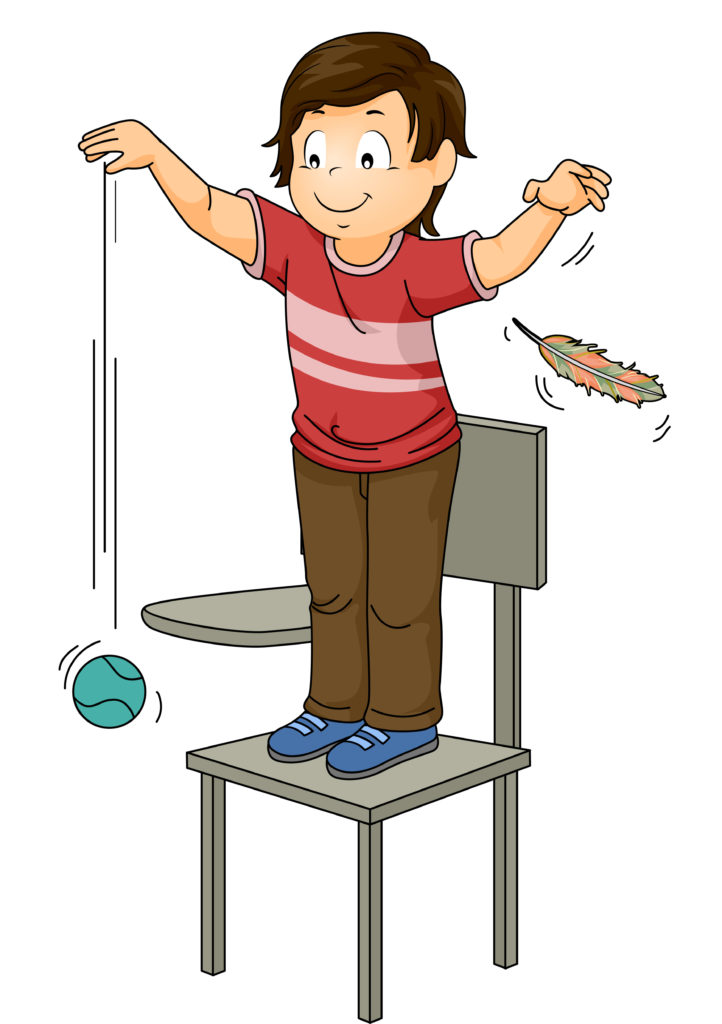
However if a ball and feather are dropped in a vacuum , where there is no air resistance as there’s no air, the ball and feather will fall together and hit the ground at the same time.
Bottle Drop Experiment
Following on from the ball and feather experiment another great example of Galileo’s discovery is to half fill one plastic bottle and leave another ( the same size ) empty. If dropped from the same height they will hit the ground at the same time!
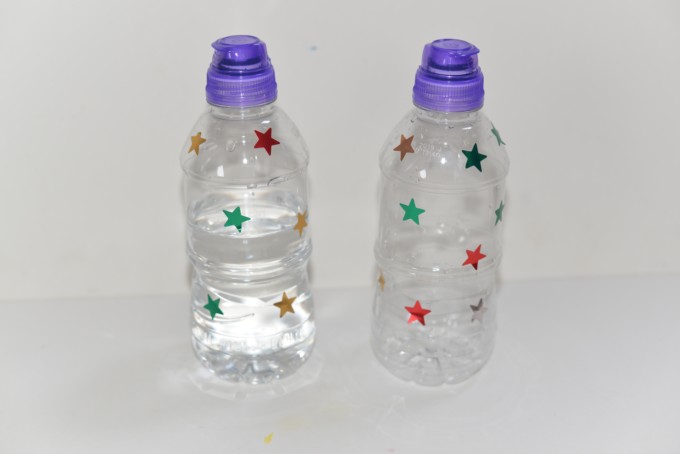
Issac Newton and Gravity
According to legend Issac Newton was sitting under an apple tree when an apple fell on his head, which made him wonder why if fell to the ground.
Newton published the Theory of Universal Gravitation in the 1680s, setting out the idea that gravity was a force acting on all matter. His theory of gravity and laws of motion are some of the most important discoveries in science and have shaped modern physics.
Film Canister Rocket
A film canister rocket is a fantastic demonstration of all three of Newton’s Laws of Motion , but it falls back to the ground thanks to gravity.
Water powered bottle rockets are another great fun example of gravity and lots of other forces too!
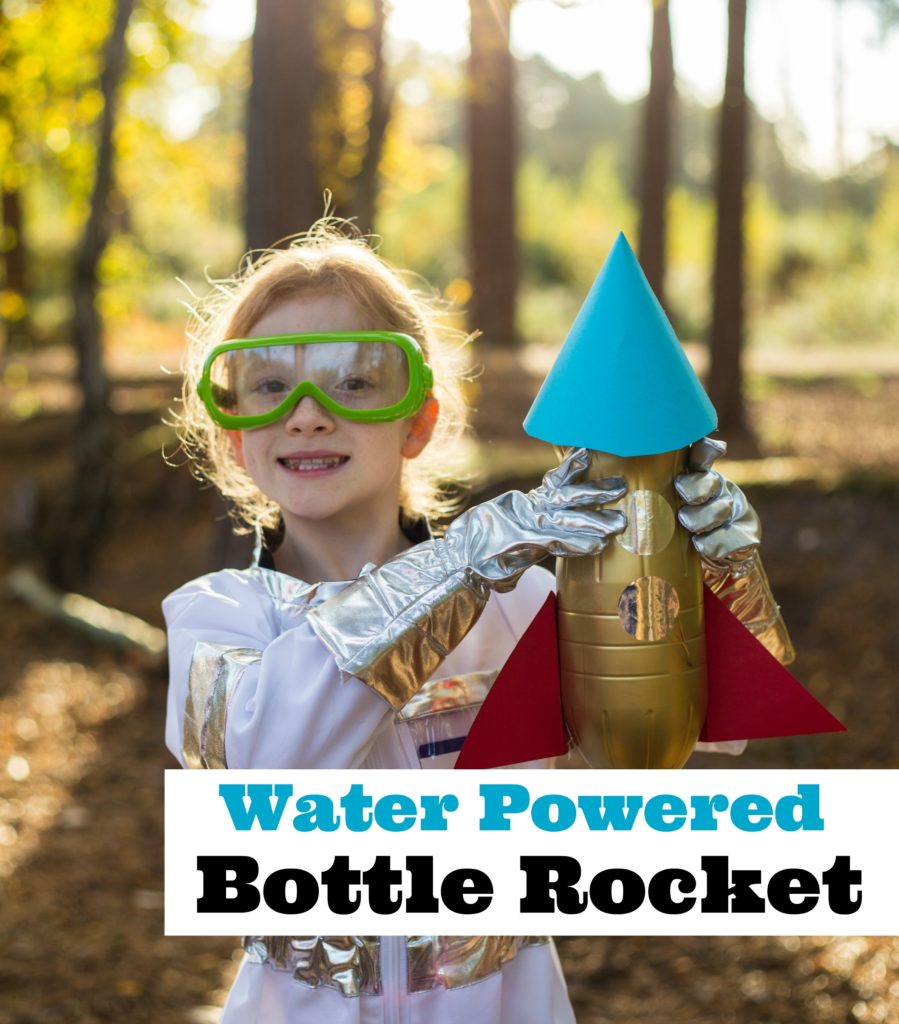
Defy gravity with a magnet
Did you know you can defy gravity using magnets. We love this activity as you can theme it however you want. Your floating object could be a spaceship in space, a flower growing towards the sun or even a plane in the sky.
The magnet holds the paperclip in the air as if it’s floating!
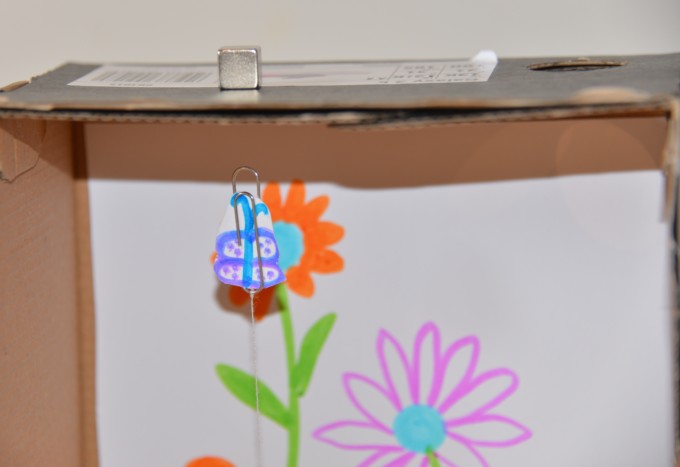
Straw Rockets – Gravity Experiment
Create your own straw rockets and launch at different angles to investigate how the trajectory changes. Of course these don’t have to be rockets, they could be anything you want, so get creative!
Parachutes are another great gravity experiment and perfect for learning about air resistance too!
Marble Runs
A DIY marble run is another hands on way to demonstrate gravity. Can you build one where the ball has enough energy to move uphill?
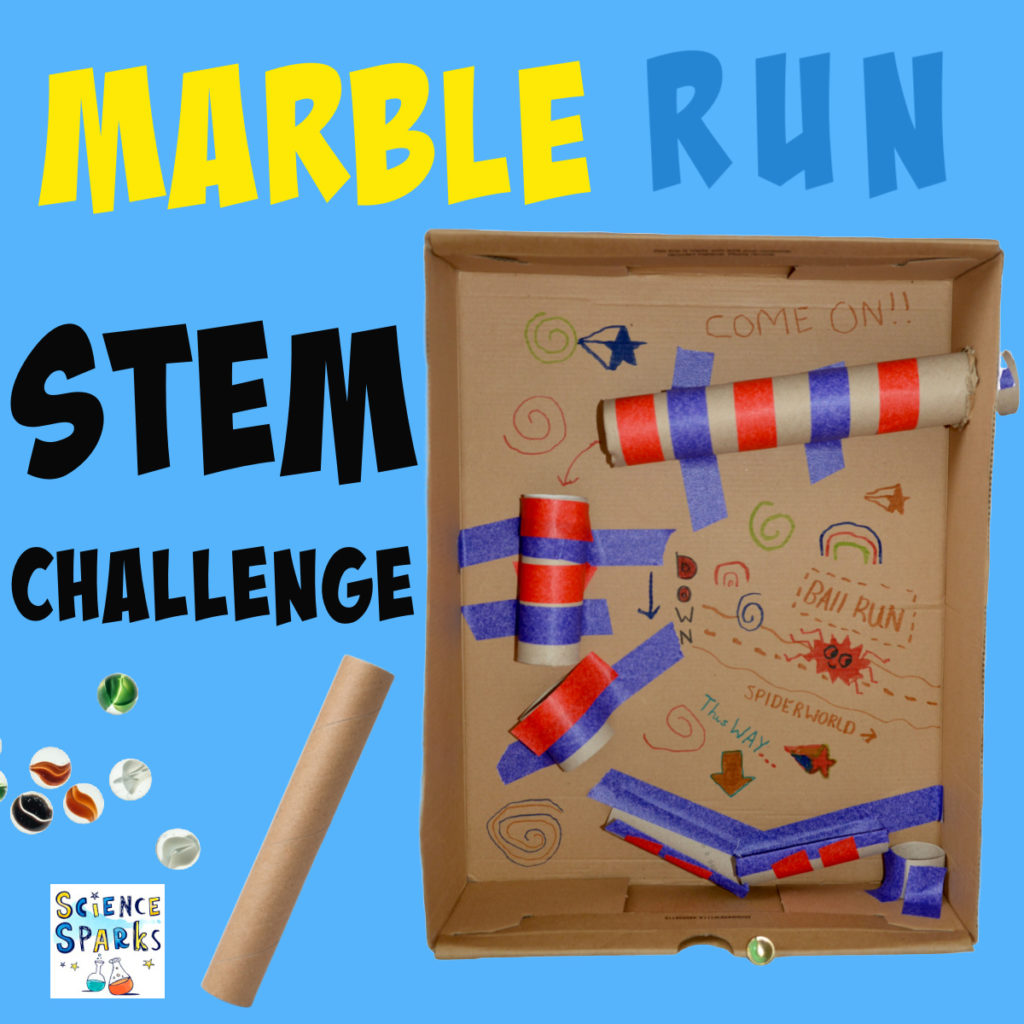
DIY Sling Shot
Finally, a simple slingshot is a brilliant and simple STEM project and perfect for learning about gravity as a shower of pom poms fall to the ground!
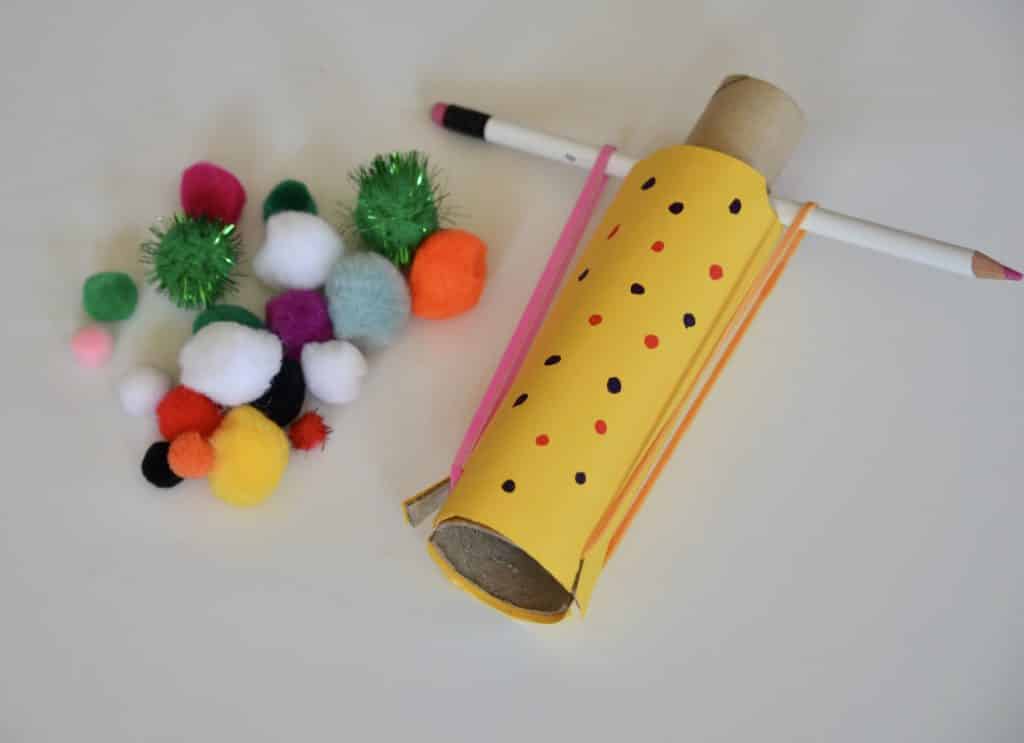
Last Updated on May 25, 2022 by Emma Vanstone
Safety Notice
Science Sparks ( Wild Sparks Enterprises Ltd ) are not liable for the actions of activity of any person who uses the information in this resource or in any of the suggested further resources. Science Sparks assume no liability with regard to injuries or damage to property that may occur as a result of using the information and carrying out the practical activities contained in this resource or in any of the suggested further resources.
These activities are designed to be carried out by children working with a parent, guardian or other appropriate adult. The adult involved is fully responsible for ensuring that the activities are carried out safely.
Reader Interactions
Leave a reply cancel reply.
Your email address will not be published. Required fields are marked *
Get Your ALL ACCESS Shop Pass here →
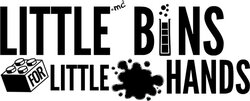
Easy Gravity Experiments For Kids
Why do things fall to the ground when you let go of them? It’s all to do with gravity! Learn about what gravity is with a simple definition and everyday examples of gravity. Explore simple physics with easy, hands-on experiments kids will love. From falling objects, balancing apples, and even an egg drop challenge, enjoy these fun gravity science projects for kids!
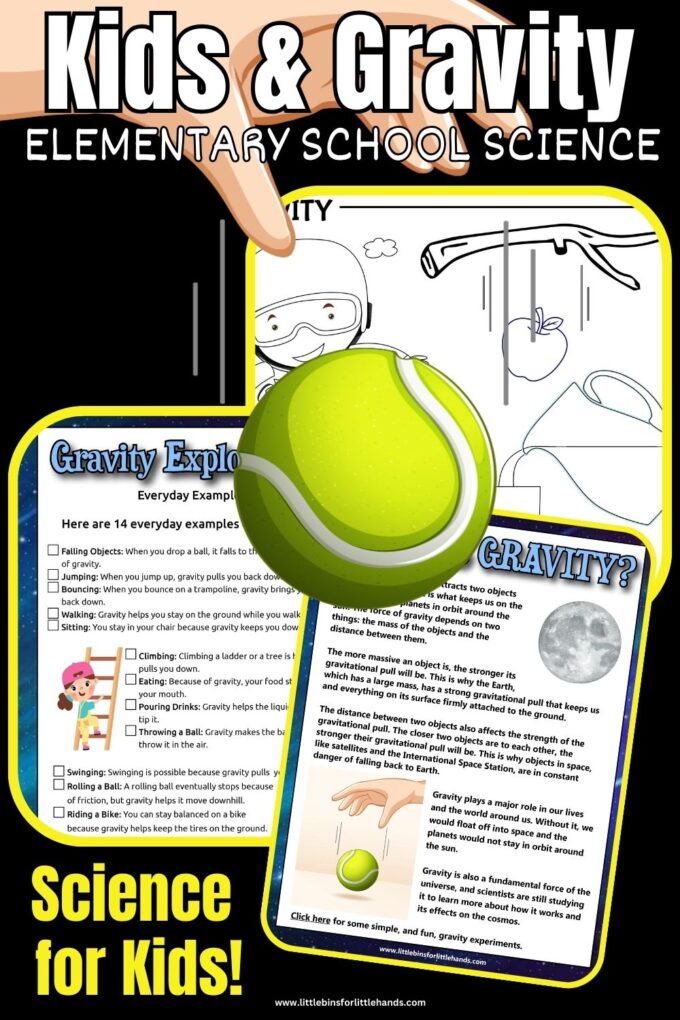
What is Gravity?
Gravity is a force that pulls objects toward each other. It’s why things fall to the ground when you drop them. On Earth, gravity pulls everything toward the planet’s center, so we stay on the ground instead of floating into space!
Gravity also keeps the planets in our solar system orbiting around the sun. The bigger something is, the stronger its gravity. So, Earth’s gravity is much stronger than the gravity of a small object like a ball, but not as strong as the sun’s gravity. Gravity affects everything around us, even though we can’t see it!
Have you ever watched a NASA video of an astronaut floating around inside his/her ship?
Galileo and Gravity
Galileo Galilei was a famous scientist who helped us understand how gravity works. He discovered that gravity is a force that pulls objects down toward the ground.
One of his famous experiments was when he dropped two objects of different weights from the Leaning Tower of Pisa to see if they would fall at the same speed. To everyone’s surprise, they did!
Galileo showed that gravity pulls all objects equally, no matter how heavy. This idea changed the way people thought about gravity and led to many important discoveries about how things move.

Ball Drop Experiment
- Two objects of different weights (like a small ball and a larger book)
- A chair or a step stool (to stand on safely)
What to do:
- Stand on the chair or stool (make sure you’re being safe!).
- Hold the two objects—one in each hand—at the same height.
- Drop both objects at the same time.
- Watch closely! Did they hit the ground at the same time?
What happens: Just like in Galileo’s experiment, you’ll see that both objects, even though they have different weights, should fall and hit the ground at the same time. This shows that gravity pulls objects to the ground at the same rate, no matter how heavy they are!
Everyday Examples of Gravity
Here are 15 everyday examples of gravity that are easy for kids to understand:
- Falling Objects: When you drop a ball, it falls to the ground because of gravity.
- Jumping: When you jump up, gravity pulls you back down to the Earth.
- Walking: Gravity helps you stay on the ground while you walk.
- Sitting: You stay in your chair because gravity keeps you down.
- Climbing: Climbing a ladder or a tree is harder because gravity pulls you down.
- Bouncing: When you bounce on a trampoline, gravity brings you back down.
- Swinging: Swinging on a swing set is possible because gravity pulls you back towards the Earth.
- Driving: Your car stays on the road because of gravity.
- Eating: Because of gravity, your food stays on your plate and in your mouth.
- Pouring Drinks: Gravity helps the liquid flow from a cup when you tip it.
- Throwing a Ball: Gravity makes the ball come back down after you throw it in the air.
- Rolling a Ball: A rolling ball eventually stops because of friction, but gravity helps it move downhill.
- Riding a Bike: You can stay balanced on a bike because gravity helps keep the tires on the ground.
- Water Flow: Water flows downhill because of gravity, which is why rivers and streams exist.
- Kite Flying: Gravity keeps the kite from flying too high, and the tension in the string is balanced by gravity pulling it downward.
Can you think of any more examples of gravity?
Free Gravity Information and Activity Pack
Get up and test gravity for yourself with a free gravity activity pack ! Share this information guide, quick activity, and gravity coloring sheet with your kids!
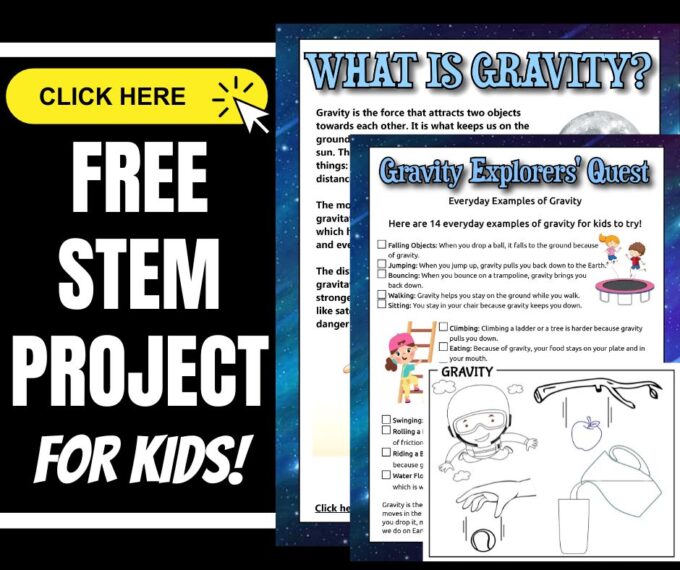
12 Gravity Experiments To Try
Here are 12 gravity science experiments that are great for elementary school kids. Learn about gravity and its effects in a fun and hands-on way.
You may also want to explore: Air Resistance Projects
Dropping Objects
Gather various objects of different weights and sizes (e.g., a feather, a paperclip, a small ball). Have kids predict which object will hit the ground first when dropped simultaneously and then test their predictions.
Paper Airplane Challenge
Have kids create paper airplanes of different sizes and shapes. Let them fly the planes and observe how gravity affects their flight paths differently based on their designs. See how to make a paper airplane launcher.

Falling Rates
Use a ruler or a measuring tape to drop different objects from the same height and measure the time it takes for them to reach the ground. Compare the falling rates of various objects.
Balloon Rocket
Attach a string to a balloon and tape the other end to a straw. Inflate the balloon and then release it. Observe how the air escaping from the balloon propels the straw in the opposite direction due to Newton’s Third Law of Motion.

Coin and Card Drop
Place a playing card on the edge of a table and let half of it hang over the edge. Hold a coin over the card’s hanging part and let it go. The card will fall due to gravity, but the coin’s rapid descent might surprise the kids as they learn about mass and air resistance .
Design A Parachute
Explore how mostly the forces of gravity and air resistance (also known as drag), slow down the descent of an object or person using a simple parachute. Vary the shape, size or material of the parachute and measure what happens.

Build A Pipeline
Make your own pipeline that will transport water from the main tank to a smaller tank using an incline. Observe how the moves because of gravity.
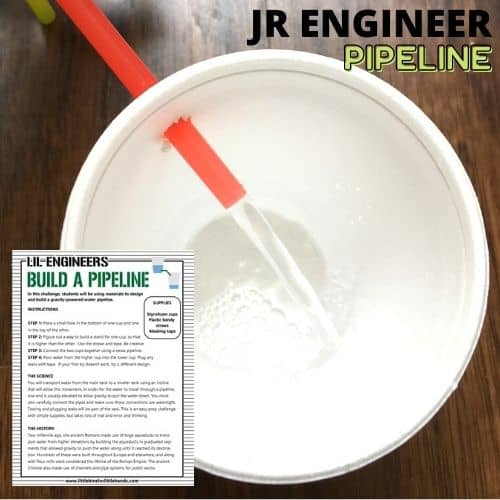
Water Upward
Fill a glass with water and place a piece of cardboard on top. Hold the cardboard and glass firmly together, then quickly turn the glass upside down. The water will stay inside the glass due to air pressure, demonstrating the balance between gravity and air pressure.
Rolling Race
Set up a ramp using books or a board. Have kids release different objects (marbles, toy cars) from the top of the ramp and see which one reaches the bottom first. Discuss how gravity affects the speed of rolling objects. See how to set it up with toy cars , pumpkins , apples and plastic Easter eggs .

Gravity-Powered Pendulum Painting
Attach a small container with paint to the bottom of a pendulum (a string with a weight at the end). Set the pendulum in motion and observe how it creates unique patterns on a piece of paper beneath it.
Crumpled Paper Drop
Crumple two pieces of paper into balls, one larger and one smaller. Drop them both at the same time and discuss how their sizes and air resistance affect their falling speed.
Balancing Act
Have kids experiment with balancing different objects on their fingertips. Discuss how the weight and shape of objects affect their balance due to the force of gravity. Have fun balancing animal puppets , mobile of paper shapes , pumpkins , and paper apples .
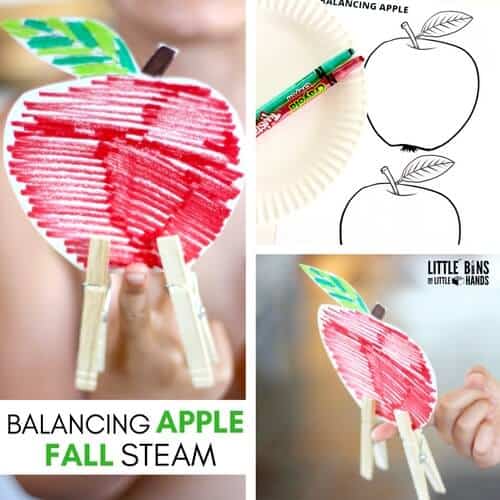
Egg Drop Challenge
Provide kids with materials like straws, rubber bands, tape, and newspapers. Challenge them to design a structure that will protect a raw egg when dropped from a certain height, demonstrating how objects experience less impact force when they have more time to slow down (larger parachutes or cushioning). See our egg drop ideas for younger and older students.
Water Wheel
Build a simple water wheel using a plastic container, a stick, and a paper cup. Place the water wheel under a steady stream of water and observe how gravity causes the wheel to turn. See how to build a simple water wheel here.
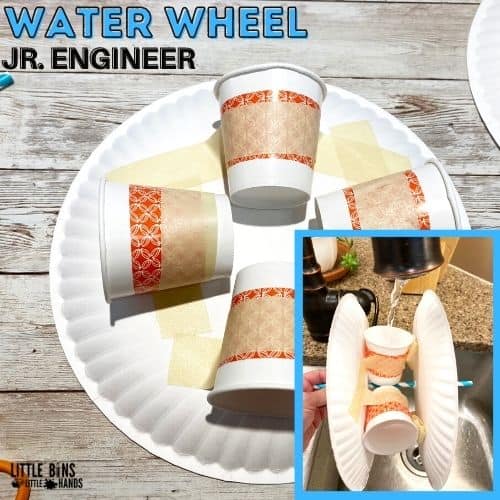
Have younger kiddos? Check out these fun gravity activities for preschool and kindergarten.
The Most Famous Gravity Experiment
Sir Isaac Newton is famous for many contributions to physics, and his experiments with gravity are among his most renowned works. One of the key experiments associated with Newton’s study of gravity is often called the “Newton’s Falling Apple,” which is a story rather than a controlled experiment.
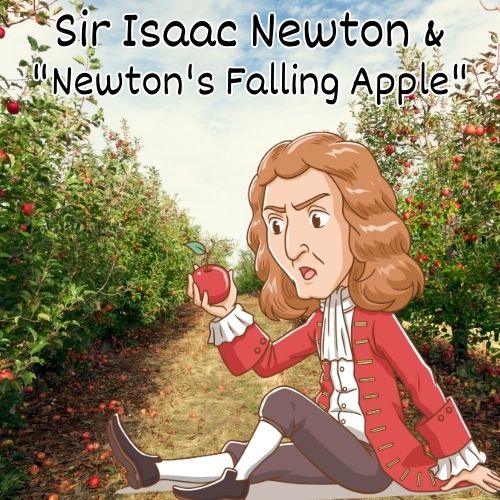
According to the legend, Newton was sitting under an apple tree in his garden when he saw an apple fall to the ground. This event got him thinking about the force that caused the apple to fall. Newton realized that the same force, gravity, was responsible for the apple’s fall and the motion of bodies in space like the Moon and planets.
Explore experiments that illustrate Newton’s Laws!
While this story is well-known, it’s important to note that it wasn’t a formal experiment. However, Newton conducted a series of experiments and observations to develop his laws of motion and the law of universal gravitation. These experiments and observations included:
- Prism Experiments: Newton’s experiments with prisms and light led to his groundbreaking work on optics, which is separate from gravity but an important part of his overall scientific contributions. See Newton’s color wheel spinner.
- Mathematical Calculations: Newton used mathematics to formulate his laws of motion and universal gravitation. He developed the mathematics of calculus to help describe and predict the behavior of objects under the influence of gravity.
- Kepler’s Laws: Newton built upon Johannes Kepler’s laws of planetary motion to develop his laws of universal gravitation. Kepler’s work was based on extensive astronomical observations.
So, while there isn’t a specific experiment directly related to the falling apple, Newton’s contributions to our understanding of gravity are based on a combination of observations, mathematical calculations, and experiments.
Have fun with physics! Check out our complete list of easy physics experiments.
Grab your FREE printable science worksheets!
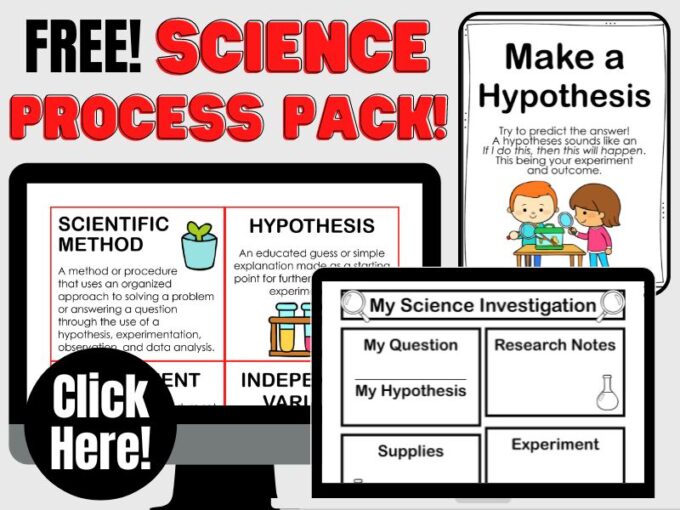
Helpful Science Resources To Get You Started
Here are a few resources that will help you introduce science more effectively to your kiddos or students and feel confident yourself when presenting materials. You’ll find helpful free printables throughout.
- Best Science Practices (as it relates to the scientific method)
- Science Vocabulary
- 8 Science Books for Kids
- All About Scientists
- Science Supplies List
- Science Tools for Kids
- Join us in the Club
More Physical Science Activities
- Light Experiments
- Magnet Activities
- Simple Machine Projects
- Potential & Kinetic Energy
- Static Electricity
- Surface Tension Experiments

Printable Science Projects For Kids
If you’re looking to grab all of our printable science projects in one convenient place plus exclusive worksheets and bonuses like a STEAM Project pack, our Science Project Pack is what you need! Over 300+ Pages!
- 90+ classic science activities with journal pages, supply lists, set up and process, and science information. NEW! Activity-specific observation pages!
- Best science practices posters and our original science method process folders for extra alternatives!
- Be a Collector activities pack introduces kids to the world of making collections through the eyes of a scientist. What will they collect first?
- Know the Words Science vocabulary pack includes flashcards, crosswords, and word searches that illuminate keywords in the experiments!
- My science journal writing prompts explore what it means to be a scientist!!
- Bonus STEAM Project Pack: Art meets science with doable projects!
- Bonus Quick Grab Packs for Biology, Earth Science, Chemistry, and Physics.

Subscribe to receive a free 5-Day STEM Challenge Guide
~ projects to try now ~.
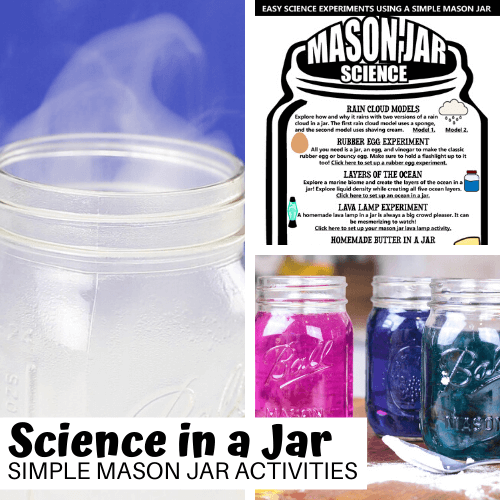
- Skip to main content
- Skip to primary sidebar

This post might contain affiliate links. Click here for more information . Thanks for visiting!
15+ Preschool Science Experiments that Explore Gravity
August 17, 2016 by Sheryl Cooper
Last Updated on July 22, 2024 by Sheryl Cooper
Inside: Explore gravity with these 7 fun preschool science experiments ! Activities that include pushing, throwing, and falling – all hands-on and fun!
Have you noticed how preschoolers are fascinated by things that move? Whether it’s pushing, throwing, or falling, they are very into it!
So why not tap into this interest?
Here are 7 fun preschool gravity experiments that you can add to your classroom or home activities , or for weekend fun.
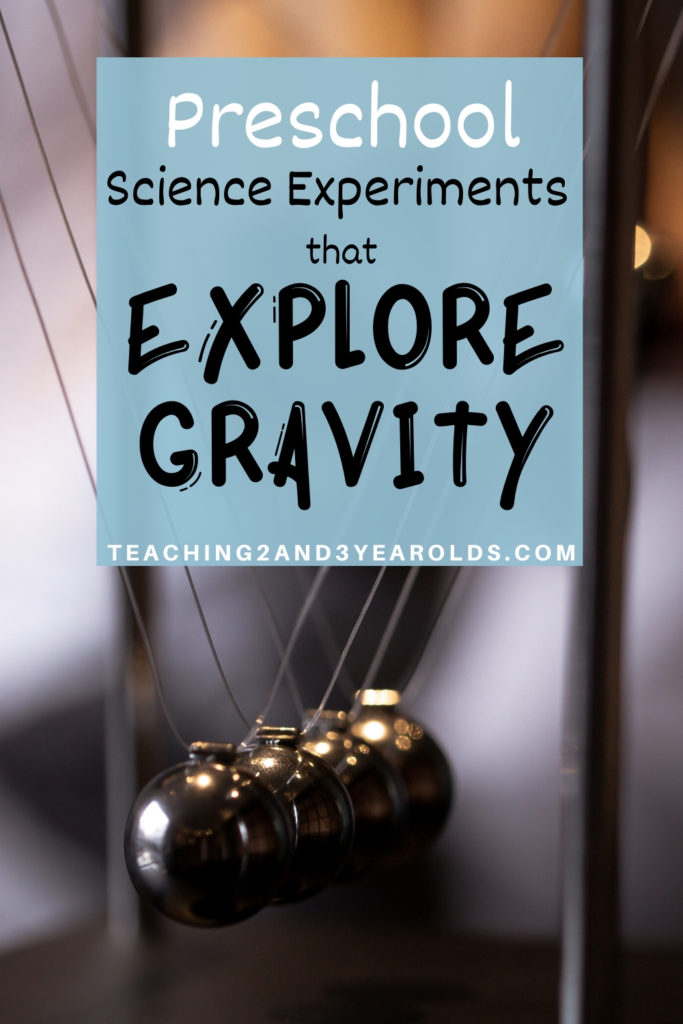
When talking about gravity with preschoolers, we keep it simple.
During our morning meeting or circle time , we demonstrate what happens if we drop an item.
We notice that it went down instead of up.
We can then try a gravity experiment during small groups, noticing that if we alter the movement or materials, things change.
This is basic and yet fascinating for this age group!
Defy Gravity – This super cool activity is easy to make with paperclips and magnets. (Buggy and Buddy)
Drip Painting – Discover what happens when watercolors are dropped from the top of a vertical surface.
Galaxy in a Bottle – The glitter doesn’t fall down, but instead rises as it settles. Crazy! (One Little Project)
Gravity Splatter Art – What happens when you drop something with paint on it?
Exploring Gravity with a Tube – Why does the position of the tube change the speed of the car? (HOAWG)
Exploring Gravity with Balance – Learn how to make a craft stick stand up right on a chopstick. (Rookie Parenting)
Gravity with a Pendulum – Learn about the forces of motion and gravity by placing paint in swinging pendulum. (Innovation Kids Lab)
Pool Noodle Gravity Play – Explore gravity and slope by making your own pool noodle marble run. (Little Bins for Little Hands)
Ball Dropping Experiment – Drop different types of balls and see which one hits the ground first. (Inspiration Laboratories)
Apple Races – Explore gravity, motion, slopes, and more as they are rolled down plastic rain gutters. (Little Bins for Little Hands)
Water in a Jar Activity – How can you stop water from coming out of a glass when it’s turned upside down? (The Homeschool Scientist)
Bottle Rocket Launch – After making your own bottle rocket, make it launch by pumping air into it. (Science Sparks)
Which One is Heavier – Make your own balance scale and find different objects to weigh. (Go Science Kids)
Parachute Egg Drop Experiment – Learn about gravity and air resistance while dropping an egg using a parachute. (Science Sparks)
Center of Gravity Balancing Activity – This Cat in the Hat inspired activity involves balancing objects on a single point. (Preschool Pool Packets)
Exploring the Effects of Speed – Learn how speed has an effect on the gravitational pull on an object. (JDaniel4’s Mom)

More science for preschoolers:
Rainbow Science Activities
Winter Science Activities
15 Space Activities
Check out our favorite science toys and materials:

More science resources:
Hands-On Preschool STEM Activities
Science Activities that Explore Gravity
10 Science Experiments Preschoolers Love
Check out our science pin board for more fun!
Free circle time planner.
Get your FREE circle time planner as a gift when you subscribe to my free weekly newsletters.
Here is my Privacy Policy
Success! Now check your email to confirm your subscription.
There was an error submitting your subscription. Please try again.
About Sheryl Cooper
Sheryl Cooper is the founder of Teaching 2 and 3 Year Olds, a website full of activities for toddlers and preschoolers. She has been teaching this age group for over 25 years and loves to share her passion with teachers, parents, grandparents, and anyone with young children in their lives.
Galileo's Experiments & Theory With Rolling Balls Down Inclined Planes
Galileo's contributions to science helped connect the heavens to Earth. He made significant contributions to human understanding of the laws of physics as universal laws. In many ways, Galileo's work contrasted with the Aristotelian view of universe. For example, Galileo hypothesized that objects experienced uniform acceleration due to gravity. He devised an experiment involving balls rolling down an inclined plane to test this theory.
Experimental Apparatus
Galileo's experimental apparatus was simple; it consisted of a wooden ramp with a groove cut into it and a bronze ball. The bronze ball would roll down the groove, and he could track its motion due to gravity. The angle at which the ramp was positioned would lessen the apparent acceleration of gravity in such a way that he could make accurate measurements. By observing this phenomenon accurately on a small scale at many different angles of inclination, he could then make assertions about free-falling bodies under the force of gravity.
Advertisement
Article continues below this ad
More For You
What is the quickest route to the moon & how long does it take, how big is outer space, how have astronomers been able to study the surface of venus, limitations for titration experiments, does "casey at the bat" use hyperbole, measuring time.
In Galileo's day, the technology for measuring time did not include digital stopwatches or any similar devices. Instead, Galileo used a water-based clock to measure time in his experiment. A container of water was raised and allowed to drip in a regular manner into a vessel below it. By weighing the amount of water in the vessel, Galileo could accurately measure the amount of time elapsed during the experiment.
Analyzing the Findings
As the ball rolled down the plane, Galileo found that it traveled down the ramp at a uniformly increasing speed. The relationship between distance traveled and time was not linear. In fact, upon analyzing his results, Galileo found that the distance traveled by the ball down the ramp was proportional to the square of the time elapsed.
Implications and Legacy
Galileo's experiment was a verification of the process of uniform acceleration. A rolling ball increased in velocity at a constant rate. This verification of constant acceleration is an instance of an object's inertia. In general, once an initial force is applied to an object, that force will continue until some other force acts against it. Galileo further studied this by testing what happened to the ball after it finished accelerating down the plane. Galileo's concept of inertia ultimately became the basis for Newton's First Law of Motion.
- Rice University: Galileo's Inclined Plane Experiment
- McMurry University: Galileo and the Mathematics of Motion
- University of Virginia: Galileo's Acceleration Experiment
- University of Tennessee, Knoxville: Galileo: The Telescope & the Laws of Dynamics
- University of Tennessee, Knoxville: Newton's Three Laws of Motion
Serm Murmson is a writer, thinker, musician and many other things. He has a bachelor's degree in anthropology from the University of Chicago. His concerns include such things as categories, language, descriptions, representation, criticism and labor. He has been writing professionally since 2008.

IMAGES
VIDEO
COMMENTS
Will a ball and a feather hit the ground at the same time? Find out with the collection of gravity experiments and learn about Isaac Newton and Galileo
Here are 15 everyday examples of gravity that are easy for kids to understand: Falling Objects: When you drop a ball, it falls to the ground because of gravity. Jumping: When you jump up, gravity pulls you back down to the Earth. Walking: Gravity helps you stay on the ground while you walk.
Can you imagine what inertia might have to do with falling objects? Figure 1, shows a ball falling over time. You know that the ball is pulled down because of gravity. However, when the ball is first dropped, it is moving more slowly because of inertia—the ball wanted to stay in place.
Ball Dropping Experiment – Drop different types of balls and see which one hits the ground first. (Inspiration Laboratories) Apple Races – Explore gravity, motion, slopes, and more as they are rolled down plastic rain gutters. (Little Bins for Little Hands)
Galileo's experimental apparatus was simple; it consisted of a wooden ramp with a groove cut into it and a bronze ball. The bronze ball would roll down the groove, and he could track its motion...
With this experiment, children can use two types of balls (basketball and tennis balls) to test how high they bounce. The resource includes a list of equipment you'll need, the steps you should follow, as well as ways to vary the experiment and find out even more about forces and gravity.